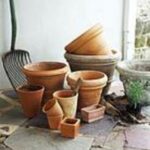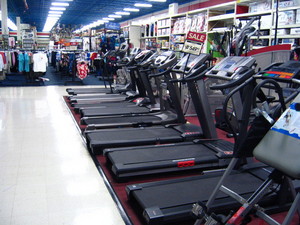Ceramics are some of the most beautiful and versatile materials used for gardening accents, including planters. Ceramic pots and planters are made of non-metalic, inorganic materials that are compressed, hardened, and molded using heat. As a result, they are air-tight, water-tight, and relatively temperature-resistant, making them ideal for outdoor planter use.
The following ceramic materials are often used to create pots and planters for outdoor gardens. Depending on your aesthetic preferences, the plants you’ll be using, and the climate of your area, any of these may suit your needs as a gardener.
Italian for “baked earth”, terra cotta is a form of ceramic created by oven-drying refined natural clay. Its natural, unglazed color is a deep brown-orange shade. This rustic, earthy appearance makes it a must-have ceramic planter in any garden that strives for a natural look, and many terra cotta potters treat this ancient artisan-craft as a work of art.
For outdoor use, terra cotta generally must be glazed in order for it to withstand rapid changes in temperature and humidity without cracking. While natural, unglazed terra cotta ceramic pots are not always well-suited for outdoor garden use, glazed planters made with this earthen material are tough and long-lasting.
Natural terra cotta ceramic planters come in a wide range of earthy, rustic colors, ranging from burnt-umber to chocolate brown. Glazed terra cotta pots can be almost any opaque color, although the best appearance is generally gained through high-gloss glazes that accentuate the natural tones of this clay-based ceramic.
Polyresin
Differing from terra cotta in that it is a light, tight ceramic material, polyresin holds some advantages over clay-based ceramic pots and planters. It is a very tight, sturdy, solid material that can be intricately molded to include elaborate decorations, and it is resistant to heat, cold, and humidity.
Because it is so tightly grained and sturdy, polyresin can be painted, glazed, or given metallic or stony finishes, making it one of the most versatile ceramic materials. Some potters create outdoor planters that combine polyresin with fiberglass or terra cotta to make it stronger or give it a slightly different look.
Polyresin ceramic planters can come in almost any size, shape, color, or form; from large white vase-type planters to small, metallic, shallow bowls. Becaues of its versatility, polyresin is one of the most widely used materials for outdoor planters.
Fiberglass
Many commercially available ceramic planters and outdoor pots are created using fiberglass, a heat-treated composite of fine glass strands. Fiberglass blends can be an excellent ceramic variety for some gardeners because it is very resistant to changes in temperature and humidity, and the versatility of glass enables a broad array of colors and styles.
Glass reflects whatever color is added to its mixture, meaning that fiberglass ceramic planters can be almost any color, with any desired level of gloss or opacity. For this reason, many gardeners chose fiberglass outdoor ceramic planters so their individual preferences can be perfectly matched.
Fiberglass is, in general, a relatively inexpensive form of ceramic planter, and is available in nearly any size. Some common shapes for fiberglass planters include bowls, ceramic vases, and cylinders, and the shape can be chosen based on your preferences and the theme of your garden.
Porcelain
Although fragile when compared to other materials, porcelain is a fine, beautiful material for use in ceramic planters. Porcelain is delicate and expensive, making it in some ways ill-suited for use in outdoor gardens, where it may be subjected to extremes in heat and cold.
Nevertheless, porcelain’s beauty makes it a candidate for use in some planters and ceramic pots, since it can thematically fit into almost any garden motif. Fine porcelain planters are often adorned with beautiful scenery, intricate patterns, and even gold finishes and accents, making it the most aesthetically appealing form of ceramic planter.
Porcelain planters are most often fishbowl-shaped or vase-shaped, and the expensive nature of the material limits its use to small and medium planters only. Estate sales and antique stores are often the most ideal places to find these garden gems.
Cement
Although rustic, cement is one of the most tried-and-true forms of ceramic for use in outdoor planters. Cement is a component material in mortar and concrete planters, and its tight-grained, stone-like texture make it a charming addition to an earthy garden.
Ceramic planters using cement can be very large since it is an inexpensive material, and are available in a wide variety of shapes and sizes. Because it is tightly grained, it can be painted any color, and different materials can be mixed into the base material to create alternative color effects.
One downside to the use of these ceramic pots is that they tend to have a large environmental impact, owing to their weight, difficulty of transport, and the massive amount of energy that must be used to harvest and process the base materials. Still, because they are heat-resistant and durable, some gardeners find them to be ideal ceramic planters for outdoor gardens.
Depending on the theme of your garden, your budget, and your own aesthetic ideals, any of these forms of ceramic planter might suit your specific needs as a gardener. Careful consideration of all available options can help you to find the material, colors, and shapes that are best for your own situation.




